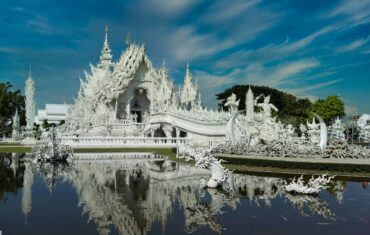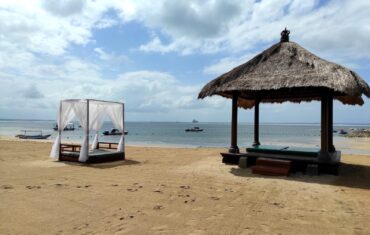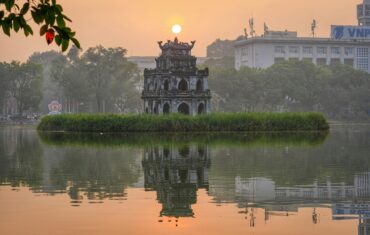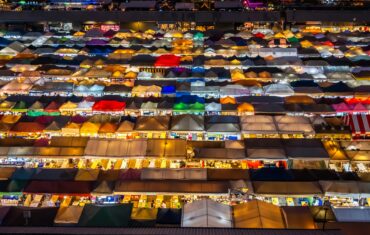Laos is the only landlocked country in Southeast Asia, without a coastline, yet it is blessed with majestic mountains, winding rivers, and lush green forests that provide rich natural resources for agriculture and forestry.
Known as “the Land of a Million Elephants” or “the Land of the Champa Flower,” Laos preserves an authentic and peaceful charm rarely found elsewhere in the region.
Despite its small size, Laos offers an exceptionally calm and spiritual atmosphere, making it an ideal destination for travelers seeking to escape the fast pace of modern life. With its unspoiled natural landscapes, ancient Buddhist temples, and traditional villages, Laos is a perfect destination for cultural, spiritual, and nature-based tourism in Southeast Asia.
GEOGRAPHY
With a total area of approximately 236,800 km², Laos shares borders with five countries: China, Thailand, Myanmar (Burma), Cambodia, and Vietnam, making it a strategically located country in Southeast Asia.
The geography of Laos is characterized by rolling hills, fertile plains, and high plateaus, creating a diverse and scenic natural landscape. The Mekong River, one of Asia’s most important waterways, flows along the country’s western border, forming a rich river system that provides abundant water resources, fertile alluvial land, and agricultural potential.
Laos is home to spectacular natural scenery, featuring pristine mountains, lush forests, and peaceful rural landscapes, making it an ideal destination for nature lovers and eco-tourism. Despite the impacts of time and past conflicts, the country still preserves many remnants of ancient civilizations, including sandstone temples, historic pagodas, and unique, mysterious architectural structures.
One of the most remarkable sites is Wat Phou, an ancient religious complex of outstanding historical and cultural significance, recognized by UNESCO as a World Heritage Site, symbolizing the spiritual depth and cultural heritage of Laos.
THE CULTURE
Laos is a multicultural country home to over 50 ethnic groups, creating a rich and diverse cultural identity. The official language is Lao, while English and French are also widely spoken, especially in tourist areas. Lao people are known for their warm hospitality, kindness, and peaceful lifestyle, which perfectly reflect the country’s calm and spiritual atmosphere.
Lao culture is deeply rooted in Buddhism, which plays a central role in daily life. The country is dotted with numerous Buddhist temples and pagodas, and monks are highly respected within society. It is common for Lao men to become monks at some point in their lives, even temporarily. In Laos, Buddhism is not only a religion but also a way of life and a cultural foundation.
Traditional Lao clothing also reflects Buddhist influence, characterized by simplicity and elegance, such as the traditional sinh and distinctive garments featuring a crossed scarf over the chest in certain regions.
Often referred to as a land of peace, Laos is filled with ancient temples, sacred towers, and historical monuments. There are approximately 1,400 temples across the country, many of which are considered architectural and artistic treasures. Notable landmarks include Pha That Luang in Vientiane, the former royal capital Luang Prabang, a UNESCO World Heritage Site, and the sacred Mount Phousi.
Lao culture flows like a river, shaping the gentle spirit and character of its people. The country celebrates many traditional festivals, such as Bunpimay (Lao New Year), That Luang Festival, the Rocket Festival (Boun Bang Fai), and traditional boat racing festivals, all highlighting the strong bond between community, nature, and spirituality.
TRADITIONAL FESTIVALS
Laos celebrates a wide variety of traditional festivals throughout the year, reflecting its deep spirituality, rich cultural heritage, and strong Buddhist influence. Among these, four major celebrations stand out:
- Solar New Year, celebrated in January
- Lunar New Year, observed in January or February according to the lunar calendar
- Lao New Year (Bun Pi May), held in April and considered the most important festival in Laos
- H’mong New Year, celebrated in December
In addition to these major events, Laos hosts many other meaningful cultural and religious festivals, such as:
- Bun Pha Vet (the incarnation of Buddha), in January
- Bun Visakha Puya (celebrating Buddha’s birth, enlightenment, and passing), in April
- Bun Bang Fai or the Rocket Festival, in May
- Bun Suang Heua, the traditional boat racing festival
- Bun Khao Phansa, the Buddhist Lent, lasting three months from July to October
Lao art and culture are vividly expressed through traditional dances, performed in both urban and rural areas. During festivals, visitors can enjoy folk performances, religious ceremonies, and traditional games, offering an authentic insight into the cultural life and spiritual traditions of Laos.
CURRENCY
The official currency of Laos is the Lao kip (LAK). Banknotes are available in denominations of 1, 5, 10, 20, 50, 100, and 500 kip, followed by 1,000, 2,000, 5,000, 10,000, and 20,000 kip, with 50,000 kip being the highest denomination currently in circulation.
Although US dollars (USD) and Thai baht (THB) are accepted in some tourist areas, major cities, and large establishments, their usage is limited. Therefore, travelers are strongly advised to exchange their money into local kip for everyday transactions while traveling in Laos.
The use of ATMs and credit cards is still relatively limited, particularly in rural areas. Many local businesses operate on a cash-only basis, making it essential to carry sufficient cash during your trip.
Travel tip: Bring small banknotes for markets, local transport, and traditional restaurants.
SAFETY
Laos is generally considered a safe travel destination for international visitors. However, as with any country, travelers are advised to take basic precautions, especially in crowded areas and popular tourist spots.
Visitors should take care of personal belongings such as cash, mobile phones, cameras, and valuables, and avoid traveling alone to remote or poorly lit areas at night. It is also advisable to carry important identification documents at all times, preferably with copies stored separately.
For added security, travelers should keep the contact details of local police or their embassy readily available. When using taxis, tuk-tuks, or bus services, it is recommended to agree on the fare in advance to prevent misunderstandings.
By following these simple safety tips, travelers can enjoy a safe and worry-free experience in Laos.
HEALTHCARE
In recent years, Laos has made significant improvements in its healthcare infrastructure, with hospitals and medical centers staffed by increasingly well-trained doctors and healthcare professionals. The country’s healthcare system continues to develop through the application of modern medical science and technology, enabling more effective disease prevention, diagnosis, and timely treatment, particularly in major cities and tourist areas.
During their stay in Laos, travelers can generally access basic medical services and receive appropriate healthcare, contributing to a safer and more comfortable travel experience.
However, before traveling to Laos, visitors are advised to be aware of common regional illnesses, such as dengue fever, influenza, and tuberculosis. Consulting a healthcare professional prior to departure for medical advice and recommended vaccinations is strongly advised. Additionally, purchasing comprehensive travel insurance that includes medical coverage is highly recommended.
TRANSPORTATION
Laos is a developing country, and its transportation infrastructure is gradually improving. Taxis are mainly available in major cities, although they are not very common. As a result, tuk-tuks, a traditional local means of transport, are widely used by both locals and tourists for daily travel.
The transportation system in Laos includes road networks, railways, air transport, and waterways, with the Mekong River playing a vital role as one of the country’s most important inland water routes.
Travelers can enter Laos by air through Wattay International Airport, the largest and main airport in the country.
Within Laos, tourists can travel by private car, tuk-tuk, or train. Train services usually operate in the morning, and ticket prices may vary depending on the season, but they remain affordable and suitable for most travelers.
CLIMATE
Laos features a tropical monsoon climate, characterized by three distinct seasons throughout the year, which greatly influence travel conditions and tourist activities.
- Rainy season (May to October): frequent rainfall occurs, mainly in the afternoons. Travelers are advised to carry an umbrella or raincoat to stay prepared for sudden showers.
- Cool and dry season (November to February): widely regarded as the best time to visit Laos, offering pleasant temperatures, clear skies, and minimal rainfall.
- Hot and dry season (March to April): temperatures rise significantly, particularly in lowland and urban areas.
Overall, the dry season lasts from November to April, with average temperatures ranging between 24°C and 30°C. In northern mountainous regions, evenings can be noticeably cooler, especially during winter months.
Thanks to its favorable climate and numerous traditional festivals, visiting Laos between November and February provides ideal conditions for cultural exploration, nature-based activities, and outdoor adventures.
TOURISM
Laos is divided into seven main tourist regions: Vientiane, Xiangkhoang, Luang Prabang, Thakhek, Savannakhet, Pakse, and Champasak. Each region showcases stunning and serene natural beauty, perfect for nature and culture enthusiasts.
In recent years, tourism in Laos has grown significantly. The government has focused on improving tourism infrastructure, organizing cultural and recreational activities, and preserving the country’s identity and cultural heritage.
Tourists can visit major attractions such as Pha That Luang, the “Great Stupa,” the most important Buddhist monument in Laos; Wat Si Saket in Vientiane, home to thousands of Buddha statues; and the Vat Phou complex in Champasak, a UNESCO World Heritage Site since 2001.
Visitors to Laos can explore pristine natural landscapes, tropical mountains, winding rivers, and vast fields, while immersing themselves in a diverse and rich culture, ensuring an unforgettable experience in a peaceful, beautiful, and unique destination.
GASTRONOMY
Laos offers a simple yet incredibly appealing culinary culture, featuring a wide range of delicious dishes made with local ingredients and authentic flavors. Laotian cuisine shares similarities with neighboring countries such as Cambodia and Thailand, combining sour, spicy, and sweet flavors in perfect harmony.
Laotians use affordable ingredients and simple cooking techniques that enhance the natural flavors of each dish while preserving the authenticity of traditional cuisine. Signature dishes include sticky rice, a staple in the local diet, and Laap, a minced meat salad whose name means “luck” in Lao. Visitors can also enjoy refreshing local beverages, such as Laotian beer, perfect for beating the summer heat.
Laotian cuisine captivates tourists with its bold flavors, authentic preparation methods, and the unmistakable aroma of its ingredients. Every bite offers a unique sensory experience, showcasing the richness and heritage of Laos’s culinary culture.
THE BEST TIME TO VISIT LAOS
The best time to visit Laos is during the dry season, from November to April. During this period, the weather is pleasant and sunny, perfect for exploring Vientiane’s historic temples or admiring the scenic multi-tiered Kuang Si Waterfall.
Important Laotian festivals also take place during this season, such as Buon Khoun Khao (Rice Harvest Festival) and Bun Pi Mai (Lao New Year), offering visitors a unique opportunity to immerse themselves in local culture and traditions.
Between November and December, river levels rise, allowing for enjoyable river cruises and a chance to experience the daily life of rural communities. This period also marks the peak tourist season in Laos, creating a lively atmosphere filled with cultural activities.
In contrast, during the rainy season, tourism slightly decreases and the landscape transforms, providing visitors with a tranquil and serene environment that is equally attractive for those seeking lush nature and authentic experiences.
WHAT YOU NEED TO KNOW BEFORE TRAVELING TO LAOS
- When taking photos with Laotian girls, it is important to keep your hands behind your back and avoid placing your hands on them, as this is considered indecent.
- Laotians are kind and friendly, but if they do not allow tourists to touch their belongings, please refrain from doing so, as they may be valuable or considered amulets.
- You should not touch or pat the head of other people, especially men, as this is considered a serious insult.
- Laotians have great respect and appreciation for Buddhism. When visiting pagodas and temples, dress appropriately (long-sleeved shirts, no hats) and avoid shouting or making loud noises.
- When leaving the hotel, remember to leave the room key at the reception. If you lose the key, you may be charged a fine.
- If you stay in a local family’s house, avoid pointing your head towards the door while sleeping, as this is considered bad luck in Lao tradition.
- If you come across a village where a rope is tied with a piece of fabric or a special symbol on the door, it signifies that entry for strangers is prohibited. Respect these signs and avoid entering such areas.
Following these guidelines from Epic Trip Asia will ensure a respectful, safe, and enjoyable experience during your trip to Laos.








